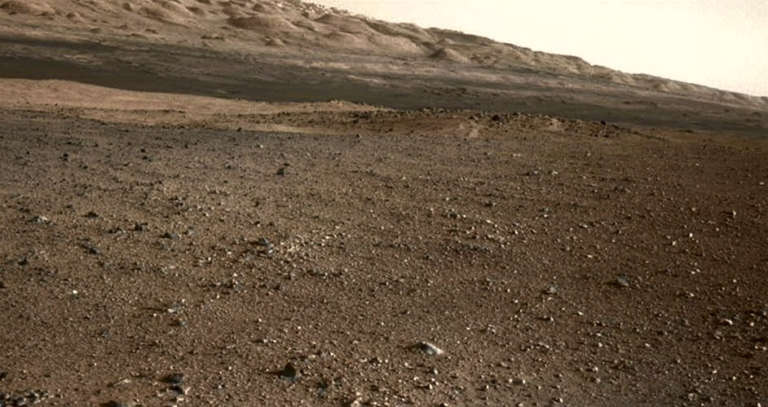Emily Lakdawalla • Aug 09, 2012
Curiosity sol 3: First Mastcam color thumbnails down, everything "flawless," "nominal"
Today's press briefing covered Curiosity's sol 3, the third full day of operations on Mars. (Landing was sol 0; different missions have used different conventions for numbering landing day.) Everything on sol 2 and 3 has gone essentially flawlessly, mission manager Mike Watkins reported. And not just on Mars; on Earth, with the function of the team, too. Which, considering the size of this team and the short planning schedule they have each day, is quite an accomplishment. Of course, it helps that most of their sequences for the first few weeks are essentially pre-planned.
The big thing that everyone was looking forward to today was a report on how the Mastcam panorama did. To briefly review, Mastcam is the main color science camera on top of the mast; there are two cameras, one a medium-angle view (Mastcam-34) and one a zoom (Mastcam-100). Up on Mars, Mastcam successfully acquired the entire panorama, 130 images. It returned thumbnail versions of all of those images to Earth, 144-pixel previews of what will eventually be 1200-pixel images. Mike Malin presented a panorama made from those thumbnails, and it's very pretty, but only a preview of what's to come.

I figured that as soon as I got back to my computer after the briefing, there would be a stunning panorama on unmannedspaceflight.com consisting of this color overlaid on the sharper Navcam panorama. There wasn't, though, and it turns out that the two panoramas have been difficult to match because they used different projections. (Any time you represent the three-dimensional world in two-dimensional space, you're warping everything in one kind of projection or another, and there is a very wide variety of ways you can do that.) So there wasn't anything available. I'm a lesser image processor than some of the geniuses over there, so I didn't even attempt the full panorama. But I thought I could give a try to a little piece of it: that geological promised land on the right-hand flank of Gale's central mountain. The result isn't perfect by a long shot, but I'm pretty pleased anyway.

During tonight and tomorrow's communications passes, sol 4, they should get a few of the full-resolution frames down from Mars. But only 10 or 20 will make it down before they begin the big flight software upgrade on sol 5. That effort will take at least 4 sols, and no science data will be returned during that time. So it'll be some time -- at least a week, more like two -- before the whole thing is available in full resolution. Even then, it won't include the top of the mountain. The panorama was planned and sequenced before the landing, so its pointing was pretty much random. Malin said that in the coming couple of weeks they have other preplanned image mosaics but that they will be able to adjust some parameters, shifting pointing slightly to better frame the pretty vistas in the distance, and the intriguing geology they contain.
One reason that the communications have been slow is that they are still limited to pretty low data rates; the maximum they have achieved so far is 256kbps. Within the next week or two, they should be able to move in to the data transmission mode with Mars Reconnaissance Orbiter that will allow rates of up to 2 Mbps. One thing I hadn't understood until I chatted with Watkins this morning was that the 2 Mbps is a maximum achievable during a single pass in which they can actually use an adaptive data rate, lower at the beginning and end of the pass when the geometry is not as good, and highest when the orbiter is most overhead. That's pretty spiffy.
I asked Malin during the press briefing if it was true -- as is my impression -- that this is a more colorful landing site than any previous one. He said he agreed with that, though he was cautious about interpreting that. Different colors don't necessarily mean different rocks. All over Mars we have red dust, black sand, tan rocks, and those are the colors we're seeing here, too. Different appearance may thus have as much to do with texture as with composition. But Dawn Sumner, also on the panel, pointed out that we know there is diverse geology here; that's why we came! And she's going to begin to try to use the MARDI color data on their HiRISE geologic maps to see how color correlates with geology.
I'll probably do one more Curiosity-related post today, but I'm taking tomorrow off. My older daughter starts school next week, and I want to take her to the beach! I've asked Jason Davis to cover any news that comes out of tomorrow's briefing, which they told us would feature the EDL team reconstructing what happened on landing day.
The Time is Now.
As a Planetary Defender, you’re part of our mission to decrease the risk of Earth being hit by an asteroid or comet.
Donate Today

 Explore Worlds
Explore Worlds Find Life
Find Life Defend Earth
Defend Earth

